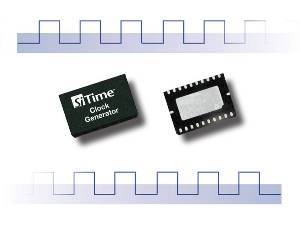Jan 27 2011
SiTime Corporation, the leader in MEMS-based silicon timing solutions, expanded its Programmable Clock Generator family with the SiT9105, a 3-PLL, 5 output device that is ideal for high-performance networking applications.
The SiT9105 is the first MEMS-based clock generator to offer mixed LVCMOS and differential outputs in a single package, while also reducing board area by up to 66%. SiTime's SiT9105 is suitable for use in routers, switches, bridges, servers, base stations, repeaters and other high-performance equipment.
 SiT9105 MEMS-Based Clock Generator with LVCMOS and Differential Outputs
SiT9105 MEMS-Based Clock Generator with LVCMOS and Differential Outputs
"Unlike the quartz industry, SiTime is using silicon technology to accelerate the pace of innovation in the timing industry," said Piyush Sevalia, vice president of marketing at SiTime. "Previously, engineers used several discrete components (resonators, oscillators and level translators) to implement the same functionality that is offered by the SiT9105. By integrating this functionality into a single package, the SiT9105 programmable clock generator offers board space, size, and BOM cost saving to the customer. In addition to integration, all SiTime devices offer many other programmable features (such as frequency, stability, and operating voltage) that are just not available from quartz suppliers."
The SiT9105 has many programmable features that can accommodate last minute design changes, accelerating the customer's time to revenue as well as saving them the cost of re-design. Combining single-ended and differential outputs on a single chip helps designers to have a reliable integrated solution. The embedded resonator removes the need for an external clock or to qualify an external crystal source. The SiT9105 saves board space -- as much as 66 percent -- by combining multiple timing sources on the board. By lowering the number of necessary design components, the SiT9105 also leads to greater design reliability.
The SiT9105 can generate up to three unrelated frequencies. This includes two frequencies on single-ended outputs (up to two copies of each frequency) and one on the differential output. The differential clock outputs support LVDS, LVPECL, or HCSL signaling levels. The SiT9105 supports any frequency from 1 to 220 MHz with 5 decimal places of accuracy, allowing the user to optimize system performance. The SiT9105 also delivers industry-best frequency stability as low as ±25 PPM and operates from 1.8V, 2.5V or 3.3V. Each output can operate off a different voltage, eliminating the need for external level translators and saving BOM cost.
Source: http://www.sitime.com/